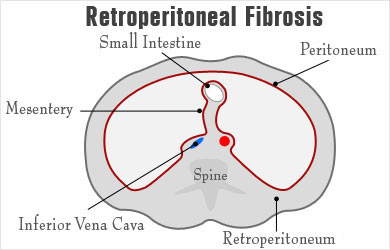

Fibrosis of the retroperitoneal connective tissues may encircle and compress the ureter(s), causing obstruction. The fibrosis is most commonly idiopathic, but can represent a reaction to infection, radiation or aortic aneurysm, or be caused by cancer or a drug reaction – methysergide, for example. Patients usually present with ill-defined symptoms of ureteric obstruction. Typically, there is an acute-phase response (high CRP and ESR).
Imaging with UVI or CT shows ureteric obstruction with medial deviation of the ureters. Idiopathic retroperitoneal fibrosis responds well to corticosteroids and may respond more slowly to tamoxifen, but ureteric stenting is often necessary to relieve obstruction. Failure to improve indicates the need for surgery (ureterolysis) both to relieve obstruction and to exclude malignancy.
CAUSES
Some medical experts have suggested that the state of your immune system has something to do with the formation of this condition.
Other possible causes of retroperitoneal fibrosis include:
SYMPTOMS
Different people may experience different symptoms. Symptoms depend on how much the growth has grown or spread and where it's located. The condition may get worse with time.
Other symptoms of retroperitoneal fibrosis, some more common than others, include:
COMPLICATIONS OF RETROPERITONEAL FIBROSIS
If left untreated for long, retroperitoneal fibrosis may develop into complications that can be hard to manage. Some of these complications include:
Other, rarer complications include:
PREVENTION
To avoid getting retroperitoneal fibrosis, don't use medication containing methysergide for long. This drug is used as a treatment medication for migraine headaches. However, researchers have found that the drug may lead to retroperitoneal fibrosis.
If you suspect that what you're feeling may be retroperitoneal fibrosis, you should consult with a professional as fast as possible. Early detection is vital to at least prevent complications and for medical treatment to work.
HOMOEOPATHIC TREATMENT
Apis mellifica: This homeopathic medicine is not used in acute forms of CKD. Symptoms of this type include oedematous swelling on the face, paleness, headaches, pain in the back and limb, oedema pulmonum, etc. It is used when there are dull aches in the kidney, reduced urination, and micturition. The urine contains albumen in high levels and blood corpuscles. An eruption of the skin occurs, and the patient feels drowsy.
Arsenicum: This homeopathy medicine is used in all stages of CKD and is one of the best remedies. It is used in later stages of the disease when the patient's skin becomes pale, and he develops a waxen appearance, excess thirst and diarrhoea. The shade of the urine is dark and full of albumen. Dyspnoea attacks are also observed while lying down during the night. Taking aconite produces a mucus and the patient gets relief.
Aurum muriaticum: This homeopathic medicine is used to cure renal diseases such as Morbus bright caused by a gout or from syphilis. Digestive and nervous problems are indicated along with great irritability. Vertigo may also be caused.
Belladonna: Belladonna is the ideal homeopathic remedy for treating inflammation of the kidneys accompanied by piercing or burning pain in the lumbar region of the kidney. The pain reappears repeatedly with increased intensity each time. No remedy has a greater irritation in the bladder and along the urinary tract than Bell. The urging to urinate is constant. The urine dribbles, and it burns intensely along the whole length of the urethra. The whole urinary tract is in a state of irritation. Bell. has cured inflammation of the bladder. With the irritation and the congestion there is all the sensitiveness to pressure we find in any other part where Bell. is indicated; sensitive to a jar. irritable state of the mind, irritable state of the whole nervous system. "Tenesmus of the bladder. After passing urine sits and strains," in torment. The urine is diminished, bloody, sometimes pure blood, or little blood clots. A considerable quantity of blood in the bladder comes away in little clots. "The urine looks as if mixed with brick dust, or streaks. Strongly acid." There is a spasmodic retention of urine and. there is involuntary passing of urine. Dribbling of urine in brain troubles. During sleep, dribbling of urine.
Sarsaparilla: Urine scanty, slimy, flaky, sandy, bloody. Gravel. Renal colic. Severe pain at conclusion of urination. Urine dribbles while sitting. Bladder distended and tender. Child screams before and while passing urine. Sand on diaper. Renal colic and dysuria in infants. Pain from right kidney downward. Tenesmus of bladder; urine passes in thin, feeble stream. Pain at meatus.
Cantharis: This homeopathic cure is used in nephritis. There is a cutting pain in the lumbar region, the urine contains blood and the flow is in the form of drops. Cantharis is used in post diphtheric kidney disorders with dropsy. -Intolerable urging and tenesmus. Nephritis with bloody urine. Violent paroxysms of cutting and burning in whole renal region, with painful urging to urinate; bloody urine, by drops. Intolerable tenesmus; cutting before, during, and after urine. Urine scalds him, and is passed drop by drop. Constant desire to urinate. Membranous scales looking like bran in water. Urine jelly-like, shreddy.